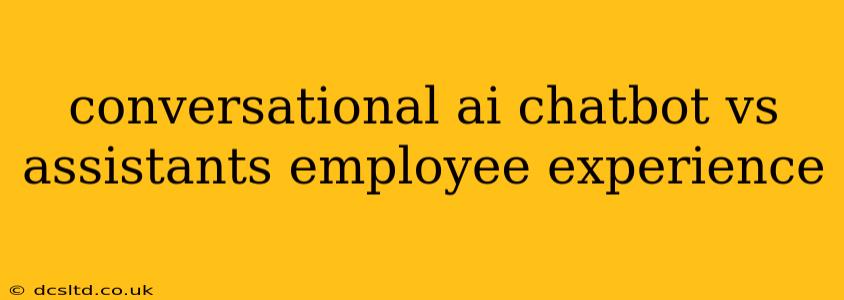The modern workplace is undergoing a significant transformation, driven largely by technological advancements. One area experiencing rapid change is employee support and communication, with conversational AI chatbots emerging as a powerful tool alongside – and sometimes in place of – human assistants. This article delves into the key differences, advantages, and disadvantages of both approaches, ultimately exploring how they impact the overall employee experience.
What are Conversational AI Chatbots?
Conversational AI chatbots are computer programs designed to simulate human conversation. Utilizing natural language processing (NLP) and machine learning (ML), they can understand and respond to employee queries in a natural, human-like manner. These chatbots can handle a wide range of tasks, from answering basic HR questions to providing IT support and scheduling meetings. Their accessibility (often available 24/7) is a significant advantage.
What is the Role of Human Assistants in Employee Experience?
Human assistants provide a personalized, empathetic, and often more nuanced approach to employee support. They possess the emotional intelligence to understand complex situations, offer tailored advice, and build stronger relationships with employees. Their ability to handle intricate requests, solve complex problems, and offer personalized guidance remains invaluable.
Conversational AI Chatbots: Advantages for Employee Experience
- 24/7 Availability: Unlike human assistants, chatbots are always available, providing instant support regardless of time zones or business hours. This significantly improves response times and reduces employee frustration.
- Increased Efficiency: Chatbots can handle a high volume of routine queries simultaneously, freeing up human assistants to focus on more complex and strategic tasks. This leads to increased overall efficiency and productivity.
- Consistency and Accuracy: Chatbots provide consistent answers and information, reducing the risk of human error or inconsistent communication. This ensures employees always receive accurate and reliable support.
- Cost Savings: While the initial investment in chatbot technology can be substantial, the long-term cost savings through reduced reliance on human assistants can be significant.
- Scalability: Chatbots can easily scale to accommodate the growing needs of a company, unlike human resources which require additional hiring and training.
Human Assistants: Advantages for Employee Experience
- Empathy and Emotional Intelligence: Human assistants can understand and respond to the emotional needs of employees, offering personalized support and building stronger relationships. This contributes to a more positive and supportive work environment.
- Complex Problem Solving: While chatbots excel at routine tasks, human assistants are better equipped to handle complex, nuanced situations that require critical thinking and creative problem-solving.
- Personalized Guidance and Mentorship: Human assistants can provide tailored advice, mentorship, and career guidance, fostering employee growth and development.
- Building Relationships and Trust: The personal interaction between an employee and a human assistant can build trust and loyalty, improving overall morale and employee satisfaction.
- Nuance and Contextual Understanding: Human assistants can interpret subtle cues and understand context in a way that current AI technology struggles to replicate.
Are Chatbots Replacing Human Assistants?
The answer is nuanced. The ideal scenario involves a collaborative approach, leveraging the strengths of both chatbots and human assistants. Chatbots can handle high-volume, routine tasks, while human assistants focus on complex issues and relationship building. This hybrid model enhances efficiency and improves the overall employee experience by providing the right support at the right time.
How to Choose the Right Approach for Your Organization
The best approach depends on several factors:
- Company size and resources: Larger organizations with significant resources might benefit from a hybrid model, while smaller companies may opt for a primarily human-assisted approach.
- Employee needs and expectations: Understanding employee needs and preferences is crucial in determining the optimal support system. Surveys and feedback mechanisms can help gather valuable insights.
- Type of support required: For routine tasks, chatbots are highly efficient. For complex issues and personalized guidance, human assistants remain indispensable.
The Future of Employee Support: A Symbiotic Relationship
The future of employee support likely lies in a synergistic relationship between conversational AI chatbots and human assistants. By combining the efficiency and scalability of chatbots with the empathy and problem-solving skills of human assistants, organizations can create a truly exceptional employee experience, fostering a more engaged, productive, and satisfied workforce.
Frequently Asked Questions
What are the limitations of conversational AI chatbots?
Conversational AI chatbots currently have limitations in handling complex, nuanced queries that require deep understanding of context and emotional intelligence. They can also struggle with unexpected or unusual requests.
How can I integrate chatbots into my existing employee support system?
Integration depends on your existing systems and chosen chatbot platform. Many platforms offer seamless integration with common HR and IT tools. Consider consulting with IT specialists to ensure a smooth transition.
What are the ethical considerations of using chatbots for employee support?
Ethical considerations include data privacy, transparency about chatbot use, and ensuring that chatbots do not perpetuate bias or discrimination. Clear guidelines and responsible implementation are crucial.
What is the return on investment (ROI) of implementing a chatbot for employee support?
The ROI varies depending on factors such as company size, implementation costs, and the extent of automation achieved. Cost savings from reduced human resources and increased efficiency are key factors contributing to a positive ROI. However, accurate assessment requires careful planning and measurement of key performance indicators.
